I’m starting to get the hang of this pintxos thing.
Dark, broody bars. Perfectly chilled wine. Plate after plate of deliciousness.
In Bilbao, pintxos bars are everywhere, but where we currently are (the Old Town) they line the perimeter of the old city square. The air is warm, but not humid. It’s perfect outdoor drinking weather and it would seem half the city agrees – they are out in their droves; kids and dogs in tow, living life to the fullest on this sunny Saturday afternoon.
Unlike the arid climate one expects while travelling through Spain, Bilbao – located on the north coast of the country, on the Bay of Biscay – is green and grungy (in a good way). Against a backdrop of lush mountains, it is a city full of art (home to the Guggeinheim Museum) and heart, of food and family-friendly activities.
Slow pace of life
Bilbao’s decidedly Basque pace of life is refreshing. On more than one occasion, I find myself thinking: “This is the way we are meant to live.” You get the feeling that – regardless of what day of the week it is – inhabitants of Spain’s Basque region (also known as Euskadi in the Basque language) are working to live and not the other way around.
We had landed in Bilbao a few days prior, via ferry, but we didn’t linger. Instead, we drove just over an hour to the city of San Sebastian – another food lover’s mecca, boasting more Michelin stars than nearly anywhere else in the world (second only to Osaka in Japan). After spending time in San Sebastian, we drove to the Ebro Valley in Rioja Alavesa to sample some local Rioja wines (La Rioja is across the Ebro river and is its own province, while Rioja Alavesa is part of Basque country).
Now, nearing the end of our journey, we are back in Bilbao, and I am on a mission to eat all the food I can find.
Starting strong with pastry
I start at Patxes (in Basque, “tx” is pronounced like a “ch” sound, so this would be pronounced “patches”). I have done zero research on where to eat, but as I walk by I notice a lineup outside this particular patisserie. This is always a good sign – people aren’t willing to wait in line for mediocrity. We eventually walk in to a small but delicious looking selection of pastries, including the chocolate-covered palmeras we see everywhere in this region, and several flavours of croissant. I choose one filled with pistachio cream and am blown away by the perfect balance of crunchy pastry, sweet glaze and earthy, nutty filling (find them on Instagram @patxes_pasteleria).
Finding the right bar
Bilbao seems to have as many pintxos bars as inhabitants, and it’s difficult to choose where to go. Pintxos is the Basque version of Spanish tapas – it’s a very social way of eating; enjoying small plates while having a drink with friends. Pintxos bars can be found throughout the city and are open early (think pre-lunch). Unlike typical tapas dishes, many pintxos are served on a slice of bread and fastened with a toothpick. While it is difficult to find a “bad” pintxos bar, we luckily have a guide from Visit Euskadi who walks us to the old town for some traditional bites.
Seafood and meat
As the Basque people have spent centuries fishing throughout the Atlantic (I am told several times about their connection with the Canadian province of Newfoundland, where they would historically fish for cod), seafood features heavily in pintxos: a scallop puree served on the half shell; delicate crab – lightly dressed in a creamy, zingy sauce; good-quality tuna mixed with the local pepper of choice – piquillo – and deep fried into one of the tastiest fish cakes you could ever taste; octopus and squid with romanesco-style sauces.
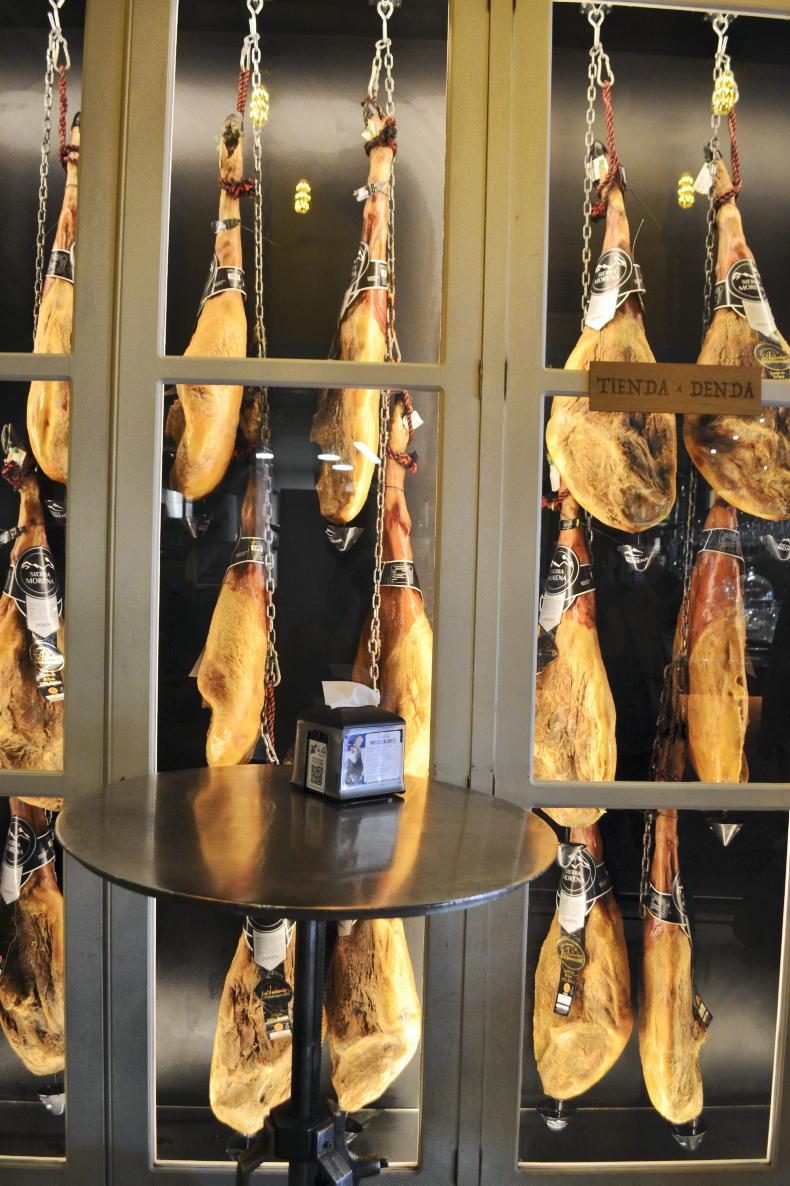
Jamon iberico - legs of air-dried ham are hung in a Bilbao pintxos bar / Janine Kennedy
If you hate seafood, though, not to worry – there are plenty of carnivorous options, with the ubiquitous jamon iberico featuring heavily in each pintxos bar – often served with crunchy, cracker-type snacks called picos and crushed tomato. Morcilla is like an Irish black pudding, but spicier and made with rice instead of oats. It bursts with flavour – as does the txorizo (chorizo sausage), which is well-spiced and served hot.
The point of pintxos
The whole point of a pintxo is to be the perfect bite to pair with your drink. Frosty cold beers and chilled txakoli (pronounced cha-ko-li), which is a local dry, slightly sparkling white wine, are the best ways to imbibe at pintxos bars in Bilbao. The easiest way to order food at these bars is to simply point at the many varieties of pintxos on display, though those in the know say ordering off the menu is preferable – the food is cooked hot, to order.

The easiest way to order pintxos is to simply point at the items on display you would like to eat. / Janine Kennedy
We do a bit of both, ordering our morcilla and txorizo from the menu on the wall and pointing to several varieties of pinxtos to sample while waiting. The cheese in this region is generally manchego – a Spanish classic – but you also see several varieties of goat’s cheese on offer.
Sardines and salt cod also feature heavily in this part of Spain, and you absolutely can’t have a pintxos experience without trying the famous gilda. Prices on pintxos vary according to what you order, and how many dishes you end up eating, but they are usually less than €5 per small plate.
Food and friends
I order a crisp txakoli to enjoy alongside my pintxos and take in my surroundings. The bars spill out onto the busy square, so drinking and eating outside is not only preferable, but encouraged.
Kids are kicking around soccer balls; friends are laughing as they eat together.
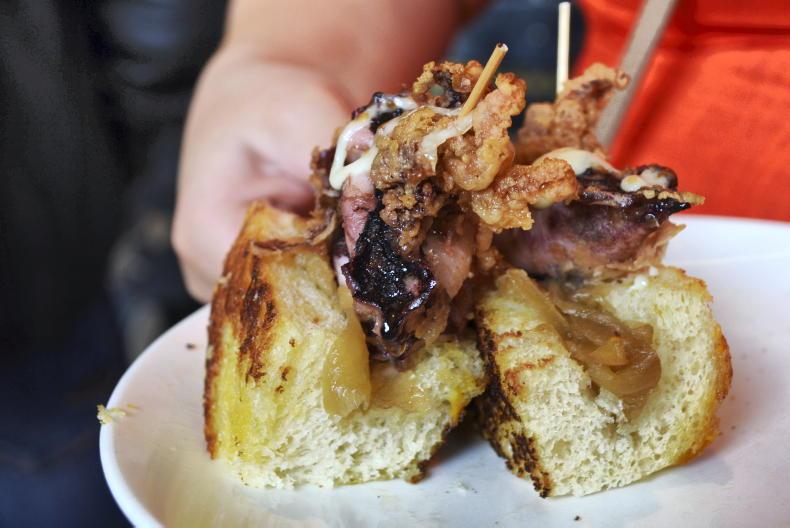
Pintxos are often presented on pieces of bread and heavily feature meat and seafood (this pintxos featured both deep fried squid and octopus). / Janine Kennedy
The food might be deep-fried and laden with rich sauces, but in many ways, the food culture I witness is entirely healthy. It is so entwined with spending time with the people you care about. I start to miss my husband and kids at this stage, and vow to come back to Bilbao. Not just for more pintxos – but to experience it with more of the people I love.
Embracing slow travel
This trip to the Basque region was courtesy of Brittany Ferries and Visit Euskadi. The Salamanca is Brittany Ferries’ newest ship; running entirely on LNG natural gas. The Salamanca is the first LNG powered passenger ferry to operate from Ireland, offering increased capacity as well as lower emissions and a quieter travel experience.
The ship sails to Bilbao from the port of Rosslare twice weekly; offering a variety of ticket options. Prices are €329 each way for a car and two people, plus a four-berth, ensuite cabin or €493 each way for a car, family of four and a dog in a kennel in the same cabin. They also offer a number of pet-friendly cabins, if you want to travel with your pet but don’t want them to travel in a kennel.
One of the more beautiful moments of my life was waking up after approximately 24 of the 28 hours we spent on the water, walking out on deck with a coffee and feeling the change in the air. It was the end of March, and I was not expecting Northern Spain to be as mild as it was at that time of year (a consistent 22°C).
After a dreary Irish winter (and a literal wash-out drive to the ferry port in Rosslare the night before), there was nothing nicer than a morning cup of coffee enjoyed in the warm sea breeze after a comfortable night’s sleep.
With access to their premium lounge and on-ship wi-fi, I was able to meet my writing deadlines while watching the many dolphins dance about the front of the ship.
I have always enjoyed travelling by ferry and train, and this voyage cemented my love of travelling by sea. It might take longer, but when you take a slower form of travel it adds to the overall experience.
Learn more at brittany-ferries.ie and euskadi.eus
Read more
Visit Malta: more to explore in the heart of the Mediterranean
Food travel: a taste of Tallinn
I’m starting to get the hang of this pintxos thing.
Dark, broody bars. Perfectly chilled wine. Plate after plate of deliciousness.
In Bilbao, pintxos bars are everywhere, but where we currently are (the Old Town) they line the perimeter of the old city square. The air is warm, but not humid. It’s perfect outdoor drinking weather and it would seem half the city agrees – they are out in their droves; kids and dogs in tow, living life to the fullest on this sunny Saturday afternoon.
Unlike the arid climate one expects while travelling through Spain, Bilbao – located on the north coast of the country, on the Bay of Biscay – is green and grungy (in a good way). Against a backdrop of lush mountains, it is a city full of art (home to the Guggeinheim Museum) and heart, of food and family-friendly activities.
Slow pace of life
Bilbao’s decidedly Basque pace of life is refreshing. On more than one occasion, I find myself thinking: “This is the way we are meant to live.” You get the feeling that – regardless of what day of the week it is – inhabitants of Spain’s Basque region (also known as Euskadi in the Basque language) are working to live and not the other way around.
We had landed in Bilbao a few days prior, via ferry, but we didn’t linger. Instead, we drove just over an hour to the city of San Sebastian – another food lover’s mecca, boasting more Michelin stars than nearly anywhere else in the world (second only to Osaka in Japan). After spending time in San Sebastian, we drove to the Ebro Valley in Rioja Alavesa to sample some local Rioja wines (La Rioja is across the Ebro river and is its own province, while Rioja Alavesa is part of Basque country).
Now, nearing the end of our journey, we are back in Bilbao, and I am on a mission to eat all the food I can find.
Starting strong with pastry
I start at Patxes (in Basque, “tx” is pronounced like a “ch” sound, so this would be pronounced “patches”). I have done zero research on where to eat, but as I walk by I notice a lineup outside this particular patisserie. This is always a good sign – people aren’t willing to wait in line for mediocrity. We eventually walk in to a small but delicious looking selection of pastries, including the chocolate-covered palmeras we see everywhere in this region, and several flavours of croissant. I choose one filled with pistachio cream and am blown away by the perfect balance of crunchy pastry, sweet glaze and earthy, nutty filling (find them on Instagram @patxes_pasteleria).
Finding the right bar
Bilbao seems to have as many pintxos bars as inhabitants, and it’s difficult to choose where to go. Pintxos is the Basque version of Spanish tapas – it’s a very social way of eating; enjoying small plates while having a drink with friends. Pintxos bars can be found throughout the city and are open early (think pre-lunch). Unlike typical tapas dishes, many pintxos are served on a slice of bread and fastened with a toothpick. While it is difficult to find a “bad” pintxos bar, we luckily have a guide from Visit Euskadi who walks us to the old town for some traditional bites.
Seafood and meat
As the Basque people have spent centuries fishing throughout the Atlantic (I am told several times about their connection with the Canadian province of Newfoundland, where they would historically fish for cod), seafood features heavily in pintxos: a scallop puree served on the half shell; delicate crab – lightly dressed in a creamy, zingy sauce; good-quality tuna mixed with the local pepper of choice – piquillo – and deep fried into one of the tastiest fish cakes you could ever taste; octopus and squid with romanesco-style sauces.

Jamon iberico - legs of air-dried ham are hung in a Bilbao pintxos bar / Janine Kennedy
If you hate seafood, though, not to worry – there are plenty of carnivorous options, with the ubiquitous jamon iberico featuring heavily in each pintxos bar – often served with crunchy, cracker-type snacks called picos and crushed tomato. Morcilla is like an Irish black pudding, but spicier and made with rice instead of oats. It bursts with flavour – as does the txorizo (chorizo sausage), which is well-spiced and served hot.
The point of pintxos
The whole point of a pintxo is to be the perfect bite to pair with your drink. Frosty cold beers and chilled txakoli (pronounced cha-ko-li), which is a local dry, slightly sparkling white wine, are the best ways to imbibe at pintxos bars in Bilbao. The easiest way to order food at these bars is to simply point at the many varieties of pintxos on display, though those in the know say ordering off the menu is preferable – the food is cooked hot, to order.

The easiest way to order pintxos is to simply point at the items on display you would like to eat. / Janine Kennedy
We do a bit of both, ordering our morcilla and txorizo from the menu on the wall and pointing to several varieties of pinxtos to sample while waiting. The cheese in this region is generally manchego – a Spanish classic – but you also see several varieties of goat’s cheese on offer.
Sardines and salt cod also feature heavily in this part of Spain, and you absolutely can’t have a pintxos experience without trying the famous gilda. Prices on pintxos vary according to what you order, and how many dishes you end up eating, but they are usually less than €5 per small plate.
Food and friends
I order a crisp txakoli to enjoy alongside my pintxos and take in my surroundings. The bars spill out onto the busy square, so drinking and eating outside is not only preferable, but encouraged.
Kids are kicking around soccer balls; friends are laughing as they eat together.

Pintxos are often presented on pieces of bread and heavily feature meat and seafood (this pintxos featured both deep fried squid and octopus). / Janine Kennedy
The food might be deep-fried and laden with rich sauces, but in many ways, the food culture I witness is entirely healthy. It is so entwined with spending time with the people you care about. I start to miss my husband and kids at this stage, and vow to come back to Bilbao. Not just for more pintxos – but to experience it with more of the people I love.
Embracing slow travel
This trip to the Basque region was courtesy of Brittany Ferries and Visit Euskadi. The Salamanca is Brittany Ferries’ newest ship; running entirely on LNG natural gas. The Salamanca is the first LNG powered passenger ferry to operate from Ireland, offering increased capacity as well as lower emissions and a quieter travel experience.
The ship sails to Bilbao from the port of Rosslare twice weekly; offering a variety of ticket options. Prices are €329 each way for a car and two people, plus a four-berth, ensuite cabin or €493 each way for a car, family of four and a dog in a kennel in the same cabin. They also offer a number of pet-friendly cabins, if you want to travel with your pet but don’t want them to travel in a kennel.
One of the more beautiful moments of my life was waking up after approximately 24 of the 28 hours we spent on the water, walking out on deck with a coffee and feeling the change in the air. It was the end of March, and I was not expecting Northern Spain to be as mild as it was at that time of year (a consistent 22°C).
After a dreary Irish winter (and a literal wash-out drive to the ferry port in Rosslare the night before), there was nothing nicer than a morning cup of coffee enjoyed in the warm sea breeze after a comfortable night’s sleep.
With access to their premium lounge and on-ship wi-fi, I was able to meet my writing deadlines while watching the many dolphins dance about the front of the ship.
I have always enjoyed travelling by ferry and train, and this voyage cemented my love of travelling by sea. It might take longer, but when you take a slower form of travel it adds to the overall experience.
Learn more at brittany-ferries.ie and euskadi.eus
Read more
Visit Malta: more to explore in the heart of the Mediterranean
Food travel: a taste of Tallinn







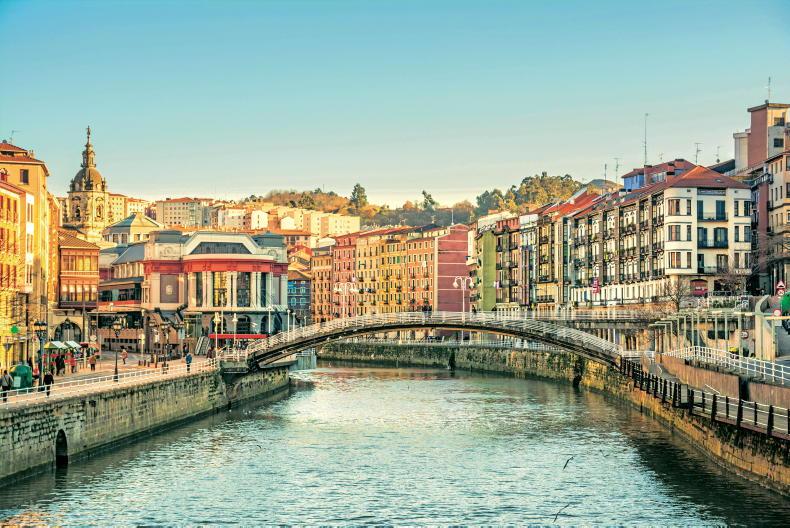
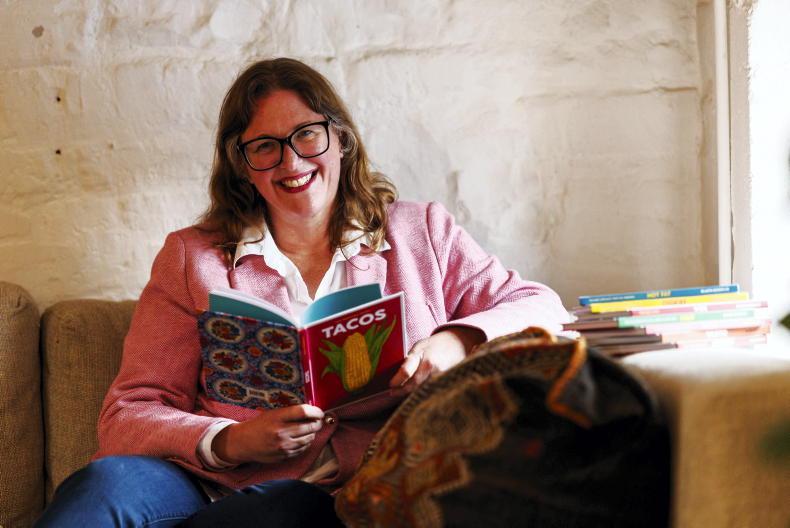
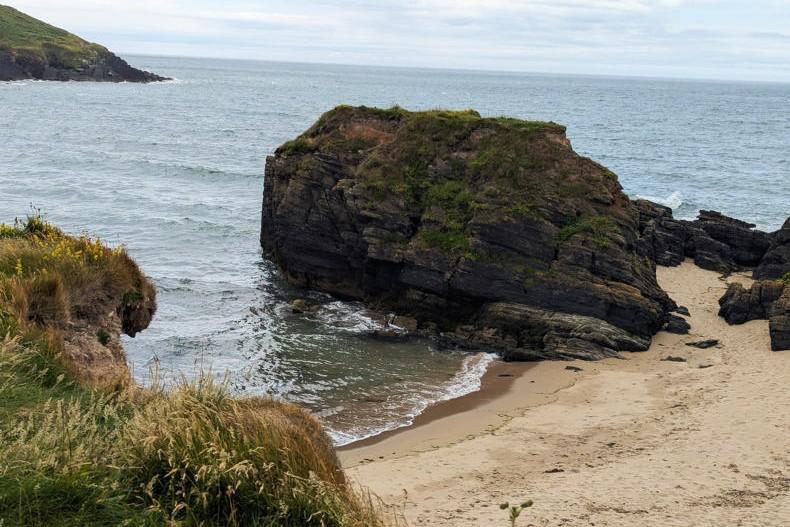

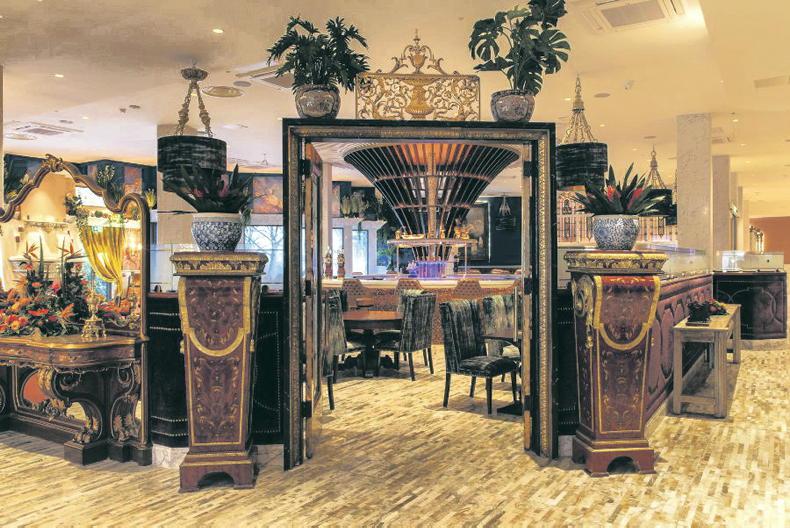
SHARING OPTIONS